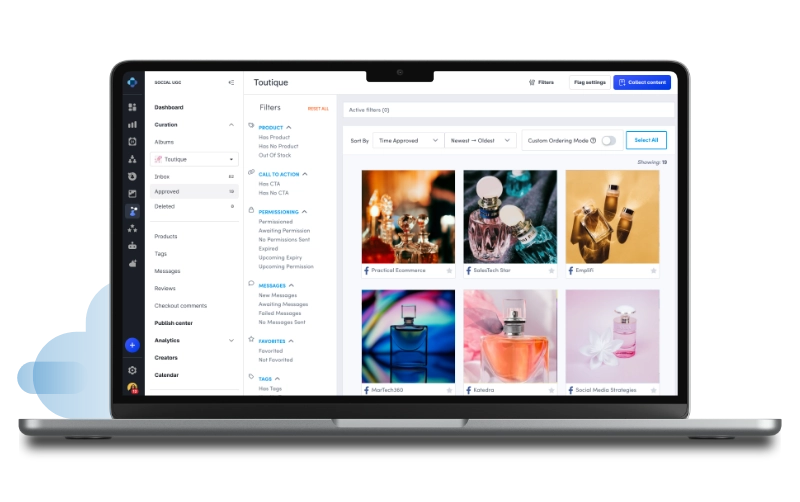What are some examples of UGC?
In practical terms, UGC for consumer brands might manifest as customers posting photos of themselves using the brand’s products, sharing positive reviews on social media platforms, creating unboxing videos, or writing blog posts about their experiences. It essentially serves as authentic and organic content generated by real users, which can be incredibly valuable for brands in several ways.
Here are some broad examples of what UGC can look like, along with some of the industries most likely to find each example helpful in orchestrating their social marketing strategy:
Product reviews and ratings
These include user-written reviews and ratings of products or services based on their experiences, which are often accompanied by a numerical rating or a written evaluation.
Relevant industries: Retail (eCommerce), Travel and Hospitality, Restaurants, Consumer Electronics, Beauty and Skincare, Fitness and Wellness.
Customer testimonials and success stories
These are personal accounts from customers detailing their positive experiences with a brand’s products or services, and often highlight specific benefits or outcomes they achieved.
Relevant industries: Education (online courses, tutoring services), Healthcare (medical treatments, wellness programs), Software and Technology (SaaS solutions, apps), Financial and Insurance Services.
User-generated photos and videos
These are images and videos captured and shared by consumers showcasing themselves using or interacting with a brand’s products or services in real-world settings.
Relevant industries: Fashion and Apparel, Travel and Hospitality, Food and Beverage, Outdoor Recreation, Home Decor and Design.
Social media challenges and hashtag campaigns
These include campaigns initiated by brands that encourage users to create and share content related to a specific theme or challenge, often accompanied by a branded hashtag.
Relevant industries: Food and Beverage (recipe challenges, cooking contests), Fitness and Wellness (workout challenges, transformation challenges), Beauty and Skincare (makeup challenges, skincare routines), Entertainment (dance challenges, lip-sync challenges).
UGC contests
These are typically social media contests organized by brands inviting users to submit their own content (e.g., photos, videos, stories) for a chance to win prizes, or simply to gain more recognition.
Relevant industries: Automotive (photo contests featuring users’ vehicles), Consumer Electronics (video contests showcasing creative uses of products), Travel and Hospitality (photo contests capturing scenic views or travel experiences), Arts and Crafts (DIY project contests using the brand’s materials).
Crowdsourced ideas and suggestions
These are platforms where users can contribute ideas, suggestions, or feedback for product improvements, new features, or brand initiatives.
Relevant industries: Software and Technology (software development, app features), Consumer Goods (product design, packaging), Media and Entertainment (TV shows, movies, video games), Automotive (vehicle features, design concepts).
These examples demonstrate the diverse forms that UGC can take across various industries, illustrating how brands can leverage UGC to enhance their marketing efforts, foster community engagement, and build brand authenticity.
Where can you find UGC?
There’s a wide variety of places you might be able to find UGC to use in your marketing efforts. The common thread among all of them is that they’re spaces online where consumers – many of whom are users of your products – gather together to share and talk about just about everything.
Conversations are happening about your brand in these spaces every day, so it only makes sense for you to be aware of, engage when the opportunity arises, and then take advantage of the amazing things people are saying about your products and services.
Here’s where UGC often materializes and the forms it often takes when it does:
Instagram
- Photos and videos posted by users showcasing themselves using a brand’s products or services.
- User-created stories featuring interactions with a brand or its offerings.
- Instagram hashtag campaigns where users share their own content related to a specific theme or promotion initiated by a brand.
YouTube
- Product reviews and unboxing videos created by consumers.
- Tutorial or demonstration videos featuring how users utilize a brand’s products.
- Vlogs documenting personal experiences with a brand’s offerings or services.
X/Twitter
- Posts sharing opinions, feedback, or testimonials about a brand or its products.
- Reposts of brand-related content by users expressing their support or endorsement.
- Chats or discussions initiated by users around a brand’s products or industry.
Facebook
- Posts on brand pages or user profiles sharing experiences, photos, or videos related to a brand.
- Reviews and recommendations left by users on a brand’s Facebook page.
- User-generated polls or surveys conducted within Facebook groups or pages related to a brand’s niche.
Reddit
- Discussions and threads within relevant subreddits discuss a brand’s products, services, or industry.
- User-generated memes or humor related to a brand’s offerings.
- AMAs (Ask Me Anything) featuring brand representatives interacting with Reddit users to answer questions and engage with the community.
Review websites (e.g., Yelp, TripAdvisor)
- Detailed reviews and ratings left by customers sharing their experiences with a brand’s products, services, or locations.
- User-uploaded photos documenting experiences or showcasing products.
- Responses to reviews from other users, providing additional insights or recommendations.
Online forums and communities (e.g., Quora, Stack Exchange)
- Questions and answers related to a brand’s products, services, or industry.
- Discussions and threads where users seek advice, share tips, or troubleshoot issues related to a brand.
- User-contributed guides, tutorials, or best practices relevant to a brand’s offerings.
Where can you use UGC?
UGC can be utilized across multiple platforms and channels to enhance brand engagement and trust. These include:
Each platform serves a unique purpose, allowing brands to connect with their audience in different contexts. For example, incorporating UGC in email marketing can personalize the customer experience, while featuring it on product pages can directly influence purchase decisions by providing social proof.
To share UGC, most brands utilize a UGC platform that collects, manages, and publishes this type of content across social and digital marketing channels. It is common to share UGC on-brand social media, and it can be very impactful to utilize it across eCommerce channels – like product pages – to inspire or inform customers during their buyer’s journey
What are the benefits of UGC?
UGC offers a variety of benefits to brands, marketers, and communities alike, fostering a more authentic, engaging, and dynamic online presence. Here are some of the key benefits:
Enhanced authenticity and trust
UGC is perceived as more genuine and trustworthy than brand-generated content because it comes from real users sharing their true experiences. This authenticity helps build trust among potential customers, making them more likely to engage with the brand.
Increased engagement
Content created by users often resonates more with other consumers, leading to higher engagement rates. Likes, shares, comments, and overall interaction tend to be greater with UGC, amplifying the brand’s reach and presence on social media and other platforms.
Social proof and influence on purchase decisions
Seeing real people endorse and use a product or service acts as powerful social proof, influencing others’ purchasing decisions. Prospective customers are more likely to be convinced by their peers than by traditional advertising.
Cost-effective content creation
UGC provides brands with a potential steady stream of content at little to no cost. Brands can leverage this content across their marketing channels, reducing the need for expensive content production resources while maintaining a fresh and updated content library.
Enhanced community and customer loyalty
Engaging with user-generated content and acknowledging contributors can encourage a sense of community and make customers feel appreciated and heard. This recognition can enhance loyalty and encourage ongoing engagement and content creation.
Valuable insights and feedback
UGC offers brands direct insights into their audience’s preferences, needs, and challenges. Analyzing UGC can inform product development, marketing strategies, and customer service practices, helping brands to better meet their customers’ expectations.
Increased conversion rates
Featuring UGC on product pages, in email marketing, or on social media can directly impact conversion rates. Consumers find user-generated reviews, photos, and testimonials more relatable, which can decrease hesitation and encourage purchases.
SEO benefits
UGC can contribute to a website’s SEO efforts. User reviews, comments, and questions add fresh, relevant content, which search engines favor. Moreover, UGC can increase the number of keywords your site ranks for, driving more organic traffic.
Diverse content
UGC encompasses a wide range of content types and styles, providing brands with a diverse content pool. This variety can make a brand’s online presence more engaging and appealing to its audiences.
Empowered customers
By encouraging UGC, brands give their customers a voice, making them feel empowered and part of the brand’s story. This inclusive approach can strengthen the emotional connection between the brand and its customers.
Incorporating UGC into a brand’s marketing strategy can thus lead to more authentic, engaging, and cost-effective campaigns, fostering stronger relationships with the audience and driving business success.
What are the benefits of using a UGC content platform
UGC content platforms offer numerous benefits for brands looking to leverage authentic consumer content. These platforms simplify the process of collecting, curating, and displaying UGC across various channels. By integrating a UGC content platform, brands can enhance their marketing strategies in several ways:
Increased engagement: UGC content platforms make it easy for brands to showcase real customer stories and experiences, which can significantly boost engagement on social media and other marketing channels.
Cost-effective content creation: By utilizing a UGC content platform, brands can reduce the need for costly professional content creation, relying instead on the authentic content produced by their customers.
Enhanced brand trust: Consumers tend to trust peer recommendations and reviews more than traditional advertising. A UGC content platform helps brands build credibility and trust with their audience.
How do you choose the right UGC content platform for your brand?
Selecting the right UGC content platform is crucial for maximizing the impact of user-generated content. Here are some key factors to consider when evaluating different platforms:
Integration capabilities: Ensure that the platform integrates seamlessly with your existing marketing tools and social media channels.
User-friendly interface: A platform with an intuitive interface will make it easier for your team to manage and curate UGC.
Advanced analytics: Look for a UGC content platform that offers robust social media analytics to track the performance of user-generated content and optimize your strategy accordingly.
Customization options: The ability to customize how UGC is displayed on your website and social media can help maintain brand consistency and aesthetic.
What are the challenges and risks of UGC?
UGC must be evaluated carefully because it is sourced directly from other people. This means a review of the content and context of what was shared is just as important as asking permission to use it. Here are some of the challenges and risks associated with UGC.
Quality control: Ensuring that UGC meets a brand’s quality standards can be challenging, as the content varies widely in terms of professionalism and relevance.
Brand reputation: Negative or controversial UGC can harm a brand’s reputation if not managed properly or if the person the content was sourced from isn’t an ideal fit for the brand.
Legal issues: Without proper permissions, using UGC can lead to copyright infringement or privacy violations.
Moderation: Monitoring and moderating content to prevent harmful or offensive material from being associated with the brand is essential but resource-intensive.
What are some UGC best practices?
Like any other form of marketing, UGC campaigns have to be executed strategically. Focus on long-term results; the best community-driven brands look to become a valuable addition and trusted resource in their customers’ lives, and that won’t happen overnight. From collection to publishing, here are some UGC best practices to help you ensure you’re getting the most value from your UGC campaigns.
Plan before sharing UGC
Does it fit your overall brand message, align with a specific campaign, or blend well with your brand aesthetic and style? From social media to emails and on-site inspiration galleries, treat UGC like you would any other marketing content.
Ask permission
Even when reposting a customer’s photo on social media, merely acknowledging the source isn’t sufficient. Obtaining explicit permission is crucial, regardless of being tagged by an open account. Social media copyright guidelines can be vague and perplexing, making it wise to err on the side of caution. Fortunately, many UGC platforms provide tools that simplify the process of requesting consent with just one click.
Engage and encourage interaction
Ask, and you shall receive! For example, use features like “Share Yours” and Question stickers on Instagram Stories to your advantage. Share content that stimulates discussion about your brand or product, and engage with your community’s original posts. This will not only get you free and excellent content but also a chance for some honest insight.
Define and measure KPIs
Map specific content creators and social posts to revenue to help your team decide which channels and post types are most valuable across the board. Defining and monitoring metrics like this can also help your team convey the value of UGC to company leadership
Encourage authenticity
Promote genuine content creation that reflects real experiences with your brand. Many brands do this through social media contests, brand hashtags, or simply asking their customers to share stories. The key is to be real because your customers will do the work of highlighting your brand or product for you.
Avoid shortcuts
Before posting on any official company channel, remember to verify the source. Reposting an image can seem harmless, but in the age of social media, where catfishing and trolling are rampant, there’s no harm in playing it safe. UGC platforms can help you ensure (at scale) that each content piece is original and authorized.
Remember not to silo all content to one channel
Most UGC comes from social media, but it doesn’t have to stay there. UGC is versatile — be sure to also pop it into other marketing channels like email, ads, in-store displays, and for eCommerce brands, basically everywhere.
Don’t limit yourself to large-scale influencers
While macro-influencers might garner more likes compared to the typical customer, it’s crucial not to underestimate the value of your everyday supporters. Highlighting experiences from individuals who resonate with your customer base can foster greater interaction and deepen your connection with them. For instance, micro-influencers, often already enthusiasts of your brand, usually experience more consistent engagement due to their specialized, focused, and dedicated audiences.
How do you collect UGC?
Collecting UGC effectively requires a strategic approach that encourages customers to share their content and makes it easy for them to do so. Here are several methods brands can use to collect UGC.
Social media hashtag campaigns
Create a unique, memorable hashtag related to your brand or a specific campaign and encourage customers to use it when posting content about your products or services. Monitor these hashtags to find and collect UGC.
Contests and giveaways
Host contests or giveaways that require participants to submit content using your product — such as photos or videos — as a way to enter. Make sure to establish clear guidelines and obtain permission to use the submitted content.
Customer reviews and testimonials
Encourage customers to leave reviews on your website, social media platforms, or third-party review sites. Consider integrating a system on your product pages that allows customers to upload images or videos along with their reviews.
Brand ambassadors and influencer partnerships
Collaborate with brand ambassadors and influencers who resonate with your target audience. While not strictly UGC, content created by these partners can be considered a form of UGC when it’s genuine and not overly commercial.
Direct requests and user permissions
If you come across user content that you’d like to use, reach out directly to the content creator to request permission. Be clear about how you intend to use their content and offer proper credit.
UGC platforms and tools
Utilize UGC platforms and tools that help in sourcing, managing, and obtaining permissions for user-generated content. These tools can streamline the process, making it easier to curate and publish UGC across your channels.
Engage with your community
Regularly engaging with your online community can encourage more UGC. Respond to posts, share user content (with permission), and create an environment where customers feel valued and excited to share their experiences.
Email campaigns
Send emails to your customers inviting them to share their experiences, photos, or videos. You can link to a submission form or provide instructions on how to share their content with you.
On-site widgets and tools
Implement widgets or tools on your website that allow customers to easily upload their content directly to your platform. This could be part of the review process or a dedicated UGC submission page.
Customer surveys and feedback requests
Use surveys or feedback requests to gather customer insights and encourage the sharing of experiences and stories. These can sometimes yield compelling content that can be repurposed with permission.
Remember, regardless of the method used to collect UGC, it’s crucial to respect copyright laws and privacy. Always obtain explicit permission from the content creators before using their content in your marketing or on your channels.

What are the best tools and platforms for managing UGC?
UGC platforms, like Emplifi, are diverse, catering to various needs from content collection and curation to engagement and analytics. These platforms can significantly aid brands in leveraging UGC across their marketing channels.
Here are a few types of UGC platforms, each serving different purposes.
Content aggregation and curation platforms
These platforms help brands collect, curate, and display UGC from various social media channels and other sources. They often offer tools for obtaining permissions, managing rights, and publishing content across websites, social media, and advertising campaigns.
Review and testimonial platforms
Focused on collecting customer reviews and testimonials, these platforms are essential for eCommerce sites and service providers. They enable the collection, management, and display of customer feedback to build trust and influence purchasing decisions.
Visual commerce platforms
Visual commerce platforms specialize in collecting and utilizing visual content like photos and videos from users. They integrate this content into eCommerce experiences, helping to enhance product pages and create shoppable UGC galleries.
Community and engagement platforms
These platforms are designed to build and manage online communities where users can share content, engage in discussions, and participate in brand-related activities. They often include features for forums, content sharing, and member profiles.
Content marketing and social media management platforms
While not exclusively for UGC, these platforms can support UGC campaigns as part of a broader content strategy. They help in organizing, scheduling, and analyzing both brand-created and user-generated content.
These influencer marketing platforms connect brands with influencers and content creators who can generate high-quality UGC. They offer tools for finding influencers, managing campaigns, and measuring performance.
Rights management platforms
Rights management platforms focus on the legal aspect of using UGC, helping brands obtain necessary permissions from content creators before using their content in marketing efforts.
Hashtag campaign tools
These tools are designed to launch, monitor, and measure the success of social media hashtag campaigns. They can aggregate content tagged with a specific hashtag, making it easier for brands to collect and showcase UGC.
Choosing the right UGC platform depends on a brand’s specific needs, including the type of content they wish to collect, their marketing goals, and the level of engagement they seek with their audience. Integrating one or more of these platforms can significantly enhance a brand’s ability to leverage UGC effectively.
How do you measure the success of UGC campaigns?
The role of UGC depends on the channel it is featured within, and success can be measured through several KPIs specific to whether you’re focused on social media or social commerce.
Engagement rate: Likes, comments, shares, and overall interaction with UGC posts.
Conversion rate: Increases in sales or desired actions directly attributed to UGC.
Brand sentiment: Changes in public perception and sentiment towards the brand as reflected in social media mentions and feedback.
Reach and amplification: The extent to which UGC is shared and seen by a wider audience.
Website traffic: UGC is a powerful tool to increase time on your website or product page or repeat visits from customers considering what you offer.
What are the legal considerations with UGC?
Legal considerations with UGC arise primarily because such content is created by individuals who are not officially affiliated with the brand or platform hosting their content. These considerations are important for several reasons:
Copyright laws: Every piece of content, whether it’s a photo, video, or text, is protected by copyright the moment it is created. When users create content, they own the copyright to their work. Brands or platforms cannot use this content without permission from the copyright holder, as doing so could result in copyright infringement.
Privacy and publicity rights: Using someone’s image, name, or personal information in marketing or commercial efforts without their consent can violate their privacy or publicity rights. This is particularly relevant when UGC includes identifiable individuals who have not provided explicit permission for their likeness to be used commercially.
Accuracy and misrepresentation: UGC may sometimes contain false, misleading, or defamatory content. Using such content without verifying its accuracy can lead to legal challenges, especially if the content damages someone’s reputation or misleads consumers.
Compliance with platform rules: Social media platforms and websites have their own terms of service and policies regarding the use of content posted on their platforms. Ignoring these policies when repurposing UGC can lead to legal issues or the removal of content.
Federal Trade Commission (FTC) guidelines: In many countries, there are regulations governing endorsements and testimonials in advertising. The FTC in the United States, for example, requires transparency when brands use UGC as endorsements. If a brand incentivizes reviews or content creation, this relationship must be disclosed.
Given these complexities, it’s crucial for brands and platforms to navigate UGC with a clear understanding of legal boundaries to protect themselves from potential lawsuits, financial penalties, and damage to their reputation. Seeking permissions, respecting copyright and privacy laws, and adhering to regulatory guidelines are key steps in responsibly managing and leveraging UGC.



















